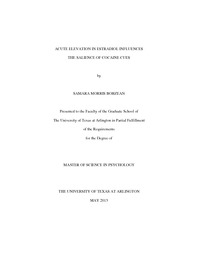
ATTENTION: The works hosted here are being migrated to a new repository that will consolidate resources, improve discoverability, and better show UTA's research impact on the global community. We will update authors as the migration progresses. Please see MavMatrix for more information.
Show simple item record
| dc.contributor.author | Morris Bobzean, Samara | |
| dc.date.accessioned | 2016-01-28T18:03:45Z | |
| dc.date.available | 2016-01-28T18:03:45Z | |
| dc.date.submitted | January 2013 | |
| dc.identifier.other | DISS-12202 | |
| dc.identifier.uri | http://hdl.handle.net/10106/25543 | |
| dc.description.abstract | Previous research demonstrates that women and female rodents are more responsive to environmental stimuli associated with drug reward than males. A growing body of literature supports a role for estradiol as one of the mechanisms underlying sex differences in the behavioral response to drugs of abuse. However, little is known about the influence of acute elevations in levels of estradiol on cocaine conditioned behaviors. Thus, the purpose of the present study was to investigate the influence of an acute increase in systemic estradiol levels on the expression of cocaine-induced conditioned place preference (CPP). Experimentally naïve, adult female Long Evans rats were ovariectomized and subjected to the following CPP paradigm: On Day 1, all animals underwent a baseline pretest to determine any pre-existing bias for the two compartments and were then randomly assigned to saline/cocaine conditioning compartments. On Days 2, 4, and 6, animals received an intraperitoneal (i.p.) injection of 0.9% saline and were confined to their assigned saline-paired compartment for 30 minutes. On Days 3, 5, and 7, they received an i.p. injection of one of three doses of cocaine hydrochloride (0, 5, or 15mg/kg) and were confined to the cocaine-paired compartment for 30 minutes. On the day of the Preference Test (Day 8), all rats received a subcutaneous injection of 5μg 17β-Estradiol 3 benzoate dissolved in 0.1mL of peanut oil (EB) or peanut oil alone (PO) 30 minutes prior to testing. On the day of the preference test, animals were allowed free access to both environments for 15 minutes. The increase in time spent in the cocaine-associated compartment was considered a measure of conditioned preference. Ovariectomized animals treated with PO alone, demonstrated CPP to both doses of cocaine. Interestingly, an acute elevation in estradiol immediately prior to exposure to the previously paired cocaine compartment increased CPP at the high cocaine dose (15mg/kg), but decreased CPP at the lower dose of cocaine (5mg/kg). All animals were sacrificed immediately following the preference test and processed with immunohistochemistry. The results revealed that EB treated females conditioned to 5mg/kg had fewer positive pCREB counts compared to EB females conditioned to 15mg/kg. EB treated females, previously conditioned to 15mg/kg doses of cocaine, had significantly more pCREB positive cells than PO treated females at the same dose. | |
| dc.description.sponsorship | Perrotti, Linda | |
| dc.language.iso | en | |
| dc.publisher | Psychology | |
| dc.title | Acute Elevation In Estradiol Influences The Salience Of Cocaine Cues | |
| dc.type | M.S. | |
| dc.contributor.committeeChair | Perrotti, Linda | |
| dc.degree.department | Psychology | |
| dc.degree.discipline | Psychology | |
| dc.degree.grantor | University of Texas at Arlington | |
| dc.degree.level | masters | |
| dc.degree.name | M.S. | |
Files in this item
- Name:
- morrisbobzean_uta_2502M_12202.pdf
- Size:
- 286.6Kb
- Format:
- PDF
This item appears in the following Collection(s)
Show simple item record


